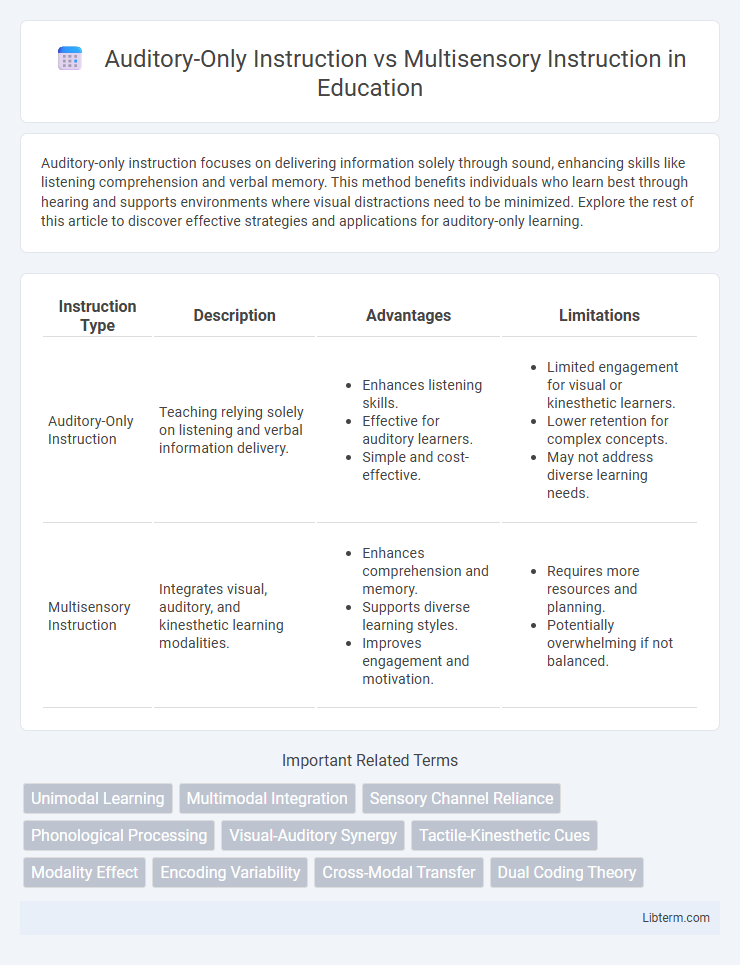Auditory-only instruction focuses on delivering information solely through sound, enhancing skills like listening comprehension and verbal memory. This method benefits individuals who learn best through hearing and supports environments where visual distractions need to be minimized. Explore the rest of this article to discover effective strategies and applications for auditory-only learning.
Table of Comparison
| Instruction Type | Description | Advantages | Limitations |
|---|---|---|---|
| Auditory-Only Instruction | Teaching relying solely on listening and verbal information delivery. |
|
|
| Multisensory Instruction | Integrates visual, auditory, and kinesthetic learning modalities. |
|
|
Introduction to Instructional Methods
Auditory-only instruction relies exclusively on listening and verbal communication, which can limit engagement and retention for learners with diverse sensory preferences. Multisensory instruction incorporates visual, tactile, and kinesthetic elements alongside auditory input to enhance comprehension, memory, and learner participation. Research indicates that multisensory approaches improve cognitive processing and accommodate various learning styles more effectively than auditory-only methods.
Defining Auditory-Only Instruction
Auditory-only instruction refers to teaching methods that rely exclusively on spoken language and listening skills without incorporating visual or tactile elements. This approach targets auditory processing abilities, emphasizing sound recognition, auditory memory, and verbal comprehension. It is commonly used in language acquisition and auditory training programs where students focus solely on listening to understand and respond.
Understanding Multisensory Instruction
Multisensory instruction engages visual, auditory, and kinesthetic-tactile pathways simultaneously, enhancing memory retention and comprehension compared to auditory-only instruction. Research shows that combining sensory inputs activates multiple brain regions, supporting deeper cognitive processing and improved learning outcomes. Effective multisensory strategies include using gestures, visual aids, and hands-on activities that cater to diverse learning preferences and boost overall academic performance.
Cognitive Theories Behind Learning Modalities
Auditory-only instruction leverages the phonological loop in Baddeley's working memory model, emphasizing the processing and retention of verbal information through sound. Multisensory instruction engages multiple cognitive pathways, such as the visuospatial sketchpad and kinesthetic sensory inputs, enhancing encoding and retrieval by creating richer memory trace networks. Cognitive Load Theory supports multisensory approaches by distributing cognitive effort across different modalities, reducing overload and improving learning efficiency.
Advantages of Auditory-Only Instruction
Auditory-only instruction enhances listening skills and promotes focused auditory processing, which is critical for language acquisition and phonemic awareness. This method reduces sensory distractions, allowing learners to concentrate solely on auditory input, improving memory retention and comprehension. It is particularly effective for auditory learners and individuals developing auditory discrimination necessary for reading and communication.
Benefits of Multisensory Instruction
Multisensory instruction enhances learning retention by engaging multiple sensory pathways, such as visual, auditory, and kinesthetic inputs. Research indicates that students exposed to multisensory teaching methods exhibit improved memory, comprehension, and problem-solving skills compared to auditory-only instruction. This approach benefits diverse learners, including those with learning disabilities, by reinforcing neural connections through simultaneous sensory experiences.
Comparative Research Findings
Comparative research findings reveal that multisensory instruction consistently enhances learning outcomes more effectively than auditory-only instruction by engaging multiple sensory pathways, which strengthens memory retention and comprehension. Studies highlight that learners exposed to multisensory techniques demonstrate improved attention, higher information recall, and better problem-solving skills compared to those relying solely on auditory input. Neurocognitive evidence supports that multisensory integration stimulates greater neural activation across sensory cortices, facilitating deeper cognitive processing.
Impact on Diverse Learners
Multisensory instruction enhances comprehension and retention for diverse learners by engaging multiple sensory pathways, such as visual, auditory, and kinesthetic inputs, which supports students with varying learning styles and needs. Auditory-only instruction often benefits auditory learners but may limit accessibility for students with auditory processing disorders or those who benefit from visual or tactile reinforcement. Research indicates that multisensory approaches improve academic outcomes, especially for learners with disabilities, English language learners, and neurodiverse students by providing multiple channels for information processing.
Practical Applications in the Classroom
Auditory-only instruction relies primarily on verbal explanations and listening activities, making it suitable for developing strong auditory processing and language skills. Multisensory instruction integrates visual, tactile, and kinesthetic elements alongside auditory input to enhance engagement and reinforce learning by activating multiple neural pathways. Implementing multisensory methods in the classroom supports diverse learning styles, improves memory retention, and benefits students with learning differences such as dyslexia or ADHD.
Recommendations and Future Directions
Research recommends integrating multisensory instruction to enhance learning retention and comprehension, as it engages multiple neural pathways compared to auditory-only methods. Future directions should explore adaptive technologies that tailor multisensory approaches to individual learner profiles and cognitive preferences. Emphasizing longitudinal studies will help determine the long-term efficacy of combining visual, tactile, and auditory stimuli in diverse educational settings.
Auditory-Only Instruction Infographic

 libterm.com
libterm.com